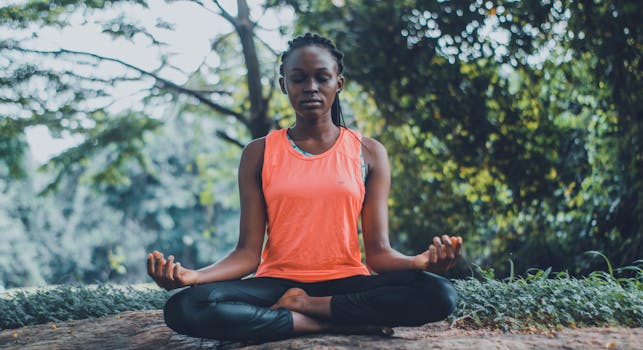
Unlocking Inner Peace: Essential Mindfulness Meditation Techniques
Takeaways: Mindfulness meditation is a powerful tool for enhancing mental clarity and emotional balance. By practicing various techniques such as focused breathing, body scan, and mindful observation, individuals can cultivate a state of awareness that leads to reduced stress and improved well-being. This article will guide you through the essential mindfulness meditation techniques, helping you incorporate them into your daily routine.
Mindfulness meditation has gained significant popularity in recent years as more people discover its remarkable benefits for mental health and overall well-being. In a fast-paced world filled with distractions and stressors, these techniques offer a sanctuary of calm and clarity. Whether you are new to meditation or seeking to deepen your practice, these mindfulness techniques can help you unlock a profound inner peace.
What is Mindfulness Meditation?

Benefits of Mindfulness Meditation

- Reduced stress and anxiety
- Improved focus and concentration
- Enhanced emotional resilience
- Better sleep quality
- Increased self-awareness
These benefits make mindfulness meditation an invaluable technique for anyone looking to improve their mental well-being and cultivate a more balanced life.
Essential Mindfulness Meditation Techniques
1. Focused Breathing
One of the simplest and most effective mindfulness techniques is focused breathing. This technique involves directing your attention to your breath, observing the natural rhythm of inhalation and exhalation. Here’s how to practice it:
- Find a comfortable seated position, either on a chair or on the floor.
- Close your eyes or soften your gaze to minimize distractions.
- Take a deep breath in through your nose, filling your lungs completely.
- Exhale slowly through your mouth, releasing any tension.
- Continue to breathe naturally, focusing your attention on each breath. If your mind wanders, gently guide your focus back to your breath.
Practicing focused breathing for just a few minutes each day can help ground you and enhance your awareness.
2. Body Scan Meditation
The body scan technique encourages you to develop a deeper connection with your body and its sensations. This practice promotes relaxation and can help reduce physical tension. Here’s how to perform a body scan:
- Lie down comfortably on your back with your arms at your sides.
- Close your eyes and take a few deep breaths to center yourself.
- Begin by bringing your awareness to your toes. Notice any sensations, tension, or relaxation.
- Gradually move your attention up through your feet, legs, hips, abdomen, chest, arms, neck, and head, spending a few moments on each body part.
- If you notice any tension, consciously breathe into that area and relax it.
Body scan meditations can be especially beneficial for those dealing with chronic pain or stress, as they promote relaxation and awareness of bodily sensations.
3. Mindful Observation
Mindful observation involves engaging your senses fully and observing your environment without judgment. This technique can be practiced anywhere, making it a versatile tool for mindfulness. Here’s how to practice mindful observation:
- Choose an object to focus on, such as a flower, a piece of fruit, or even a simple cup.
- Examine the object closely, observing its colors, shapes, textures, and any other details.
- Allow yourself to experience the object fully. What thoughts or feelings arise as you focus on it?
- After a few minutes, shift your attention to your surroundings, noticing sounds, smells, and other sensory experiences.
This technique encourages you to be present and fosters appreciation for the beauty in your environment.
4. Loving-Kindness Meditation
Loving-kindness meditation, or Metta, is a practice that focuses on cultivating love and compassion towards yourself and others. This technique can significantly enhance your emotional well-being. Here’s how to practice loving-kindness meditation:
- Find a comfortable position and close your eyes.
- Begin by silently repeating phrases such as “May I be happy, may I be healthy, may I be safe, may I live with ease.”
- After a few minutes, shift your focus to someone you care about and repeat similar phrases for them.
- Gradually expand your circle of compassion to include acquaintances and even those you find difficult.
This practice can foster a sense of connection and empathy, enhancing your overall emotional health.
5. Walking Meditation
Walking meditation combines mindfulness with movement, making it an excellent practice for those who find stillness challenging. Here’s how to engage in walking meditation:
- Find a quiet place where you can walk back and forth.
- Begin to walk slowly, paying attention to each step. Notice the sensations of your feet touching the ground.
- Coordinate your breath with your steps, inhaling for a few steps and exhaling for the next few.
- Keep your awareness on the act of walking and the surroundings, letting go of distractions.
Walking meditation is an excellent way to practice mindfulness while incorporating movement, making it accessible for those who prefer active engagement.
Incorporating Mindfulness Meditation into Your Daily Life
Integrating mindfulness meditation into your daily routine doesn’t have to be a daunting task. Here are some practical tips to help you get started:
- Start Small: Begin with just a few minutes a day and gradually increase the duration as you become more comfortable.
- Create a Routine: Set aside a specific time each day for your practice, whether in the morning, during lunch, or before bed.
- Use Guided Meditations: Consider using apps or online resources that offer guided meditations to help you stay focused and engaged.
- Be Patient: Mindfulness is a skill that takes time to develop. Be gentle with yourself and recognize that it’s normal for thoughts to wander.
By incorporating these mindfulness meditation techniques into your daily life, you can cultivate a greater sense of peace, clarity, and emotional resilience.






